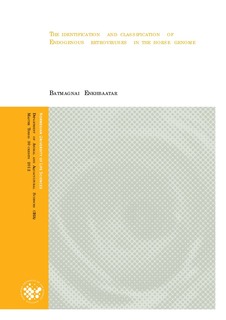The Identification and Classification of Endogenous Retroviruses in the Horse Genome
Master thesis
Permanent lenke
http://hdl.handle.net/11250/186173Utgivelsesdato
2012-11-08Metadata
Vis full innførselSamlinger
- Master's theses (IHA) [318]
Sammendrag
Endogenous retroviruses (ERVs) are sequences that derived from ancient retroviral infections of germ
cells and integrated in humans, mammals and other vertebrates millions years ago. These ERVs are
inherited according to Mendelian expectations in the same way as all other genes in the genome. Size
of complete endogenous retrovirus is between 8-12 kb long in average and contains gag, pro, pol and
env genes that always occur in the same order. Coding sequences are flanked by two LTRs (Long
Terminal Repeat sequences). Most ERVs are defective that are carrying multitude of inactivating
mutations. However some ERVs still have open reading frames in their genome. These ERVs settle
close to functional genes or within the genes and can influence or control functions of the host genes
using their LTRs. Most integration has deleterious effects. However some integration could be
example of positive co-adaptation as syncitin which is involved to form the syncytial layer of the
placenta. The first equine endogenous beta retrovirus which is EcERV-Beta1 has been found in 2011
by Antoinette C. van der Kuyl1. The first known beta retrovirus and few pol gene similar to foamy
retrovirus were only known endogenous retroviruses fixed in the domestic horse (Equus caballus)
genome. Our aim of the study was to identify other endogenous retrovirus sequences in an equine
genome and classify them into groups. Based on the high number of SINEs (Equine Repetitive
Element) in the horse genome we hypothesized that certain ERVs will be located sufficiently close to
SINEs that they will be amplified using an unbiased SINE-PCR approach with degenerate primers.
The nearest SINE element was located 5.5 k bp upstream at the 5’of the EcERV-Beta1. Pan-pol PCR
was also used to find novel ERVs based on 640 bp long region of pol gene which is the most
conserved region of ERVs. 27 complete and novel ERVs that are 13 beta, 13 gamma, 1 spuma and
249 candidate endogenous retroviruses have been revealed using LTR_STRUC tool and double
checked by Retrotector© online tool and NCBI-BLAST tool. It was proven that EcERV-Beta1 which
has 2 LTRs with 1% divergence between LTRs has a polymorphism among 13 different breeds.
